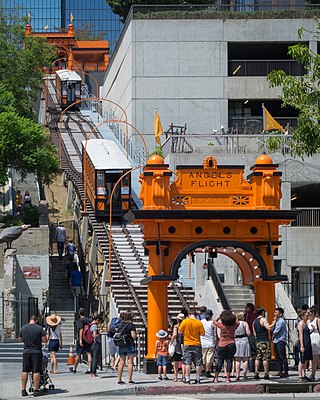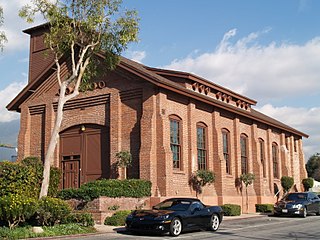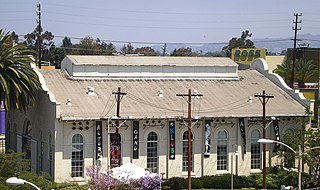
The Pacific Electric Railway Company, nicknamed the Red Cars, was a privately owned mass transit system in Southern California consisting of electrically powered streetcars, interurban cars, and buses and was the largest electric railway system in the world in the 1920s. Organized around the city centers of Los Angeles and San Bernardino, it connected cities in Los Angeles County, Orange County, San Bernardino County and Riverside County.

Angels Flight is a landmark and historic 2 ft 6 in narrow gauge funicular railway in the Bunker Hill district of Downtown Los Angeles, California. It has two funicular cars, named Olivet and Sinai, that run in opposite directions on a shared cable. The tracks cover a distance of 298 feet (91 m) over a vertical gain of 96 feet (29 m).

Olvera Street, commonly known by its Spanish name Calle Olvera, is a historic pedestrian street in El Pueblo de Los Ángeles, the historic center of Los Angeles. The street is located off of the Plaza de Los Ángeles, the oldest plaza in California, which served as the center of the city life through the Spanish and Mexican eras into the early American era, following the Conquest of California.

The Ennis House is a residential dwelling in the Los Feliz neighborhood of Los Angeles, California, United States, south of Griffith Park. The home was designed by Frank Lloyd Wright for Charles and Mabel Ennis in 1923 and was built in 1924.

The Los Angeles Railway was a system of streetcars that operated in Central Los Angeles and surrounding neighborhoods between 1895 and 1963. The system provided frequent local services which complemented the Pacific Electric "Red Car" system's largely commuter-based interurban routes. The company carried many more passengers than the Red Cars, which served a larger and sparser area of Los Angeles.

Fort MacArthur is a former United States Army installation in San Pedro, Los Angeles, California. A small section remains in military use by the United States Air Force as a housing and administrative annex of Los Angeles Air Force Base. The fort is named after Lieutenant General Arthur MacArthur. His son, Douglas MacArthur, would later command American forces in the Pacific during World War II.

Cypress Park is a densely populated neighborhood of 10,000+ residents in Northeast Los Angeles, California. Surrounded by hills on three sides, it sits in the valley created by the Los Angeles River and the Arroyo Seco. It is the site of the Rio de Los Angeles State Park, the Los Angeles River Bike Path and other recreational facilities. It hosts one private and four public schools.

The historic Subway Terminal, now Metro 417, opened in 1925 at 417 South Hill Street near Pershing Square, in the core of Los Angeles as the second, main train station of the Pacific Electric Railway; it served passengers boarding trains for the west and north of Southern California through a mile-long shortcut under Bunker Hill popularly called the "Hollywood Subway," but officially known as the Belmont Tunnel. The station served alongside the Pacific Electric Building at 6th & Main, which opened in 1905 to serve lines to the south and east. The Subway Terminal was designed by Schultze and Weaver in an Italian Renaissance Revival style, and the station itself lay underground below offices of the upper floors, since repurposed into the Metro 417 luxury apartments. When the underground Red Line was built, the new Pershing Square station was cut north under Hill Street alongside the Terminal building, divided from the Subway's east end by just a retaining wall. At its peak in the 20th century, the Subway Terminal served upwards of 20 million passengers a year.

Pacific Electric Railway Company Substation No. 8, also known as the Altadena Substation, is a former traction substation in Altadena, California. It operated under the Pacific Electric Railway and served as the substation for Pasadena area lines.

The STILE Downtown Los Angeles by Kasa, originally built as the California Petroleum Corporation Building and later known as the Texaco Building, is a 243 ft (74 m), 13-story highrise hotel and theater building located at 937 South Broadway in downtown Los Angeles, California. It was the tallest building in the city for one year after its completion in 1927, and was the tallest privately owned structure in Los Angeles until 1956. Its style is Spanish Gothic, patterned after Segovia Cathedral in Segovia, Spain.

The Hollywood Subway, as it is most commonly known, officially the Belmont Tunnel, was a subway tunnel used by the interurban streetcars of the Pacific Electric Railway. It ran from its northwest entrance in today's Westlake district to the Subway Terminal Building, in the Historic Core, the business and commercial center of Los Angeles from around the 1910s through the 1950s. The Subway Terminal was one of the Pacific Electric Railway’s two main hubs, the other being the Pacific Electric Building at 6th and Main. Numerous lines proceeded from the San Fernando Valley, Glendale, Santa Monica and Hollywood into the tunnel in Westlake and traveled southeast under Crown and Bunker Hill towards the Subway Terminal.

The Neutra Office Building is a 4,800-square-foot (450 m2) office building in the Silver Lake section of Los Angeles, California. The building was owned and designed by Modernist architect Richard Neutra in 1950. It served as the studio and office for Neutra's architecture practice from 1950 until Neutra's death in 1970. The building has been declared a Historic Cultural Monument and listed on the National Register of Historic Places. It was listed for sale in 2007 at an asking price of $3,500,000.

El Pueblo de Los Ángeles Historical Monument, also known as Los Angeles Plaza Historic District and formerly known as El Pueblo de Los Ángeles State Historic Park, is a historic district taking in the oldest section of Los Angeles, known for many years as El Pueblo de Nuestra Señora la Reina de los Ángeles del Río de Porciúncula. The district, centered on the old plaza, was the city's center under Spanish (1781–1821), Mexican (1821–1847), and United States rule through most of the 19th century. The 44-acre park area was designated a state historic monument in 1953 and listed on the National Register of Historic Places in 1972.

The Plaza Substation was an electrical substation that formed a part of the "Yellow Car" streetcar system operated by the Los Angeles Railway from the early 1900s until 1963. After being threatened with demolition in the 1970s, the Plaza Substation was added to the National Register of Historic Places in 1978.

Northeast Los Angeles is a 17.18 sq mi (44.5 km2) region of Los Angeles County, comprising seven neighborhoods within Los Angeles. The area is home to Occidental College located in Eagle Rock.

Ivy Substation is a 99-seat theatre in Culver City, California which formerly housed power equipment for the nearby electric railways and Ivy station. It was listed on the National Register of Historic Places in 1981.

Pacific Dining Car is a culturally significant luxury steakhouse business in Los Angeles California. It was founded in 1921 by Fred and Grace Cook in the backyard of a friend's house in Los Angeles. In 1990, it expanded to Santa Monica. In 2020, it underwent a shift to delivery and takeaway services due to the COVID-19 pandemic, and then moved temporarily to online offerings and popups. In August 2024, the structure was heavily damaged by fire. Wes Idol III, the great-grandson of the founders, said restoration efforts would continue.

















